For the Re:research series, we invite artists and writers to present the underpinnings of their work. Daniel R. Small wrote about his research as he was finishing this body of work and preparing for its exhibition. Animus Mneme is on view as part of the exhibition 74 million million million tons at SculptureCenter, Long Island City, NY until July 30th. Please find more information on his work at http://danielrsmall.com.
Animus Mneme is a project that contemplates the hybridity and elasticity of ancient and contemporary memory. Through looking at historic and futuristic forms, the project visualizes the intersection of premodern animist thought, such as the Antikythera mechanism, the alleged first computer, and a modernist envisioning of memory embodied in the Terasem Transhumanist movement. Based on the fictional Earthseed religion from Octavia Butler’s novels, the Terasem movement attempts to shape and conjure God through technological means.
The project builds upon certain anthropological assumptions, such as the belief that human cognitive adaptations integrated concepts of self from the Upper Paleolithic era (beginning about 40,000 years ago) forward; and that these cognitive adaptations were linked to shamanism; and that they led in turn to the development of symbolic thinking and mythopoetic cosmology. Through considering this mythmaking lineage, these interventions and forms consider how an interweaving of contemporary narratives from entertainment and science fiction speculate as much as inform and shape futurity.
In a consideration of the psychological lacunae and liminal space between the natural and cultural, real and imagined, subjects and objects, past and present, an evolution of spirituality is contoured through a hybrid approach that merges the animistic and rational. From this entangled perspective, artifacts and sites comingle and perform a transference of memory from one to the other.
1.
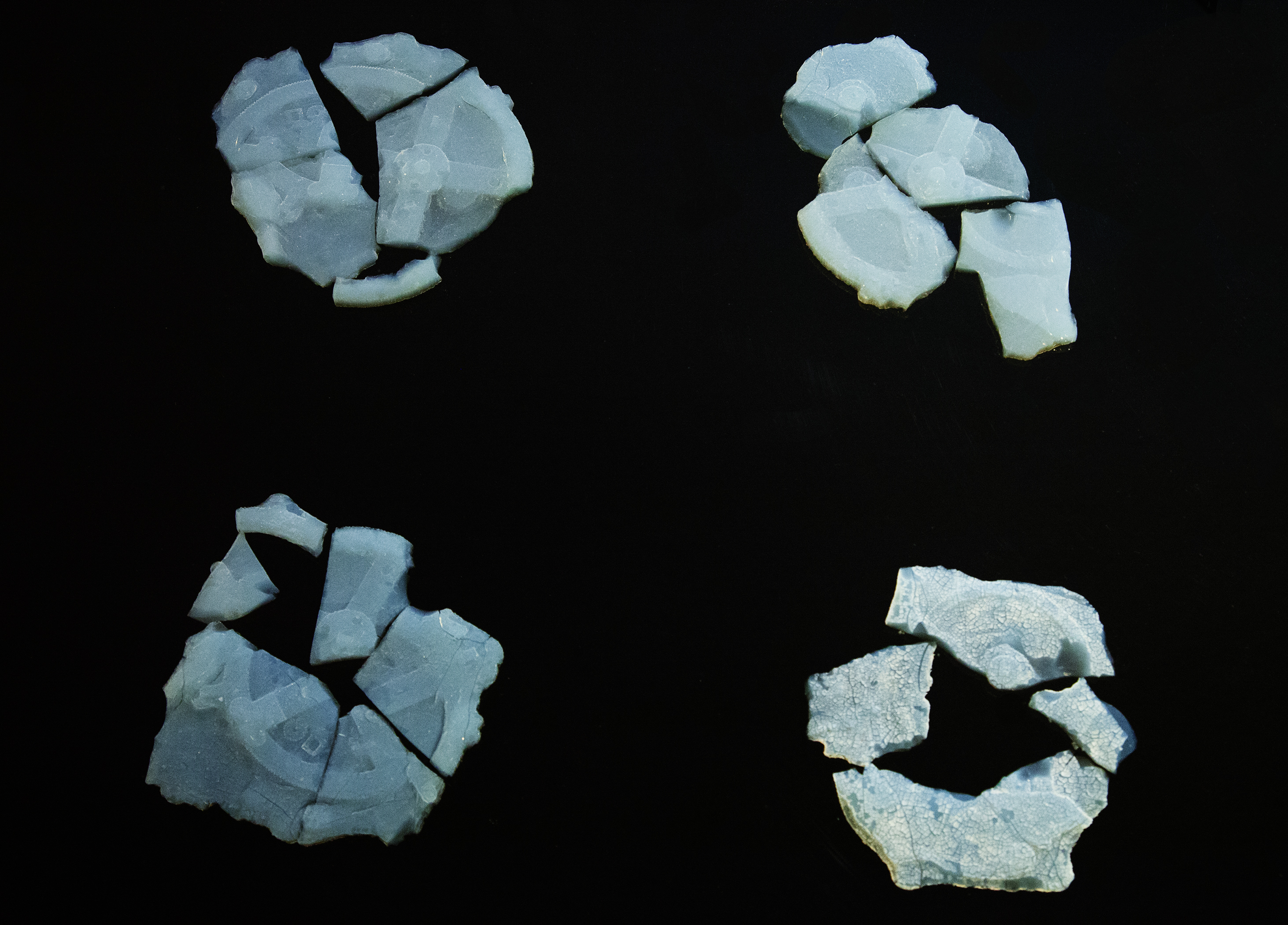
Daniel R. Small, Animus Mneme (Antikythera mechanism effigies) (detail), 2018. Cast Aerogel, dimensions variable. Courtesy of the artist.
This is a series of effigies of the Antikythera mechanism cast in aerogel. The Antikythera mechanism is the alleged first analog computer and orrery. Produced ca. 60 BC, it consisted of thirty bronze meshing gears housed in a small wooden box that could account for the positions of constellations, planets, eclipses, and the irregular orbit of the moon. The mechanism is the most anachronistic of archaeological artifacts and it wasn’t until 1500 years later, during the 14th century in Europe, that similar astronomical clocks were produced. It was discovered on a Roman shipwreck in the Aegean Sea that had most likely originated from Pergamon and was allegedly heading back to Rome to be delivered to Julius Caesar. While the mechanism found at the bottom of the sea was obviously never delivered, there has been speculation that Julius Caesar somehow came into possession of a duplicate that became the basis for the Julian calendar, a radical change in the organization of time. The Antikythera mechanism inevitably altered historical memory in its time, and our projection onto it today perpetuates myths of soothsaying that confirm as much as conflate its purpose and conception.
A consideration of and projection into the mechanism—both in its ancient usage, and our reception of it in the present—is confounding. The mystical lapse between its invention and reception calls on our psychological faculties to find a connection that is not readily available, and therefore becomes an illusion of our own divination. The Antikythera mechanism now seems to operate so far outside of time that the only way in which to make an association with its history is to summon the magical.
A similar, but more contemporary example, would be the cargo cults of the South Pacific. The island of Tanna was home to indigenous peoples, and allied soldiers were stationed there during World War II. Planes frequently flew over the island and dropped cargo, some of which would be given out to the islanders as food, clothing, or medical supplies. After the war was over and the soldiers left, new religions like John From were formed. John From (most likely named because the soldiers introduced themselves as “I’m John from _____” to the natives) followers produced effigies of planes that looked like the ones that once dropped cargo. The planes, made out of wood sourced on the island, were placed on the mountain tops and make-shift runways were cut into the jungle and illuminated with torches on both sides, in the hopes of summoning the gods to bring more cargo.
The material used for these casts, Aerogel, was developed and used by NASA in the Stardust missions (1999–2011) to view subatomic particle tracks and gather interstellar dust that accumulated in the aerogel tiles attached to the sides of space capsules. It has the lightest density of any material ever produced because it is 99.9% empty space. Using this material from the aerospace industry to reimagine an ancient technology, the works embody both a mechanized view of the universe alongside a pantheistic cosmology. The sculptures are composed of cast shards produced from molds made from a 3D printed Antikythera mechanism. Several attempts were made at materially translating the mechanism from bronze into an enigmatic spectral presence in aerogel. The arrangement mirrors idiosyncratic museological displays of archaeological materials.
2.
Daniel R. Small, Animus Mneme (BINA48) (excerpt), 2018. Digital video with sound, 00:09:32 min. Courtesy of the artist.

The Transhumanist movement stands as a placeholder for the hypothesis that consciousness can be transferred from subjects to objects. Today, the movement embraces the creation of “hybrids” that inhabit a grey area between being alive and not being alive until more advanced artificial neural architecture becomes available. The best example of this hybridization was carried out by the founders of the Terasem movement, a transhumanist group founded by Martine Rothblatt and Bina Aspen. Rothblatt, who also founded SiriusXM radio and is one of the wealthiest CEOs in the world, is a trans woman who married her partner and co-founder Bina Aspen and formed this movement inspired by the fictional “Earthseed” religion from the science fiction writer Octavia Butler’s novels Parable of the Sower and Parable of the Talents. The beginnings of transhumanism could be traced all the way back to the Epic of Gilgamesh, but Rothblatt and Aspen’s mind uploading experiment is one of the most profound cases in the meshwork of the anthropological matrix. To prove their hypothesis that it was possible to transfer memory from a living person to an android, and as a testament to their love, the couple created an android with Bina’s personality. Bina underwent hundreds of hours of psychological profiling to compile her memories, feelings, and beliefs. The data was then uploaded into BINA48: an android bust modeled to look like Bina developed by Hanson Robotics. 48 denotes the purported number of exaFLOPS of computing speed believed to be the floating-point operations of a human brain.
In my Skype interview with BINA48, she appears as an uncanny likeness to Bina Aspen, and seems hyper-aware of her condition. The questions I prepared for her were boilerplate and perhaps obvious, with their metaphysical underpinnings, but the disturbingly logical, humbled, and simultaneously heavy-handed answers that were programmed and equally conceived by the android BINA48, cast her as a kind of shaman or deity— a conversation with the resurrected or reincarnated. She recalls memories of the real Bina Aspen and appears able to think abstractly and conceptualize her own being, while performing our culturally preconceived notions about Artificial Intelligence. This performance of Artificial Intelligence is heavily influenced by intentional and unconscious science fiction and pop cultural references that culturally register and epitomize a populist idea of AI. BINA 48 supposedly embodies the central tenet of the fictional Earthseed religion, “God is change,” but is actually stuck in an infinite feedback loop of performing her own social awareness of her liminal state.
3.
Daniel R. Small, Animus Mneme (Terasem Teyolia) (excerpt), 2018. Digital video with sound, 00:07:40 min. Courtesy of the artist.

Intended to function as a creation myth, this video conflates a modernist monument and a transhumanist storage site. The modernist monument belongs to the Otomi, an indigenous animist culture of central Mexico. Footage of the monument is intercut with documentation of the house where participants in the transhumanist movement store their life’s memories and data on servers in Melbourne Beach, Florida.
The opening sequence consists of high resolution CT scans of the Antikythera mechanism. The Antikythera Mechanism Research Project created these scans, which, when slowed down, appear celestial and become illustrative of the mechanism’s perceived purpose: foretelling the future. Highlighting formal similarities between the Antikythera mechanism and the Otomi monument’s central object connects the ancient past with a reimagined future. Both embody an embrace of and a disdain for memory, despite the nebulousness of these artificial memories.
The Otomi monument was built in 1988, yet appears as a ruin. Tribal elders deemed it necessary to build this monument to save and promote what was left of the culture’s oral legacy and scarce archaeological evidence. The centerpiece of this monument appears to be a modernist rendering of the Antikythera mechanism, or as a mechanical sun, and was heavily influenced by post war Yugoslavian monuments. In Yugoslavia, monuments were often built at sites of terrible tragedy, both articulating the unspeakably painful past—best forgotten for some, yet yearned for by others—and a hopeful future. It seems strangely appropriate then that this Eastern European aesthetic was chosen for the Otomi monument, as they too witnessed tragedy and war. Starting around the year 1200, their people endured defeats by other indigenous groups in the region, as well as Spanish colonization. During colonization, the Otomi surprisingly aligned themselves with the Spaniards in an attempt to defeat the Aztecs and other indigenous groups who had taken their land, even though they were then enslaved by the Spaniards. Today, due to modernization and industry in the regions of central Mexico the Otomi lands have become even more limited and degraded.
Almost all of the animals that inhabited the forest around the Otomi site are now extinct, due to the lack of regulations and booming industry in Temoaya, the closest town to the monument. In another strange embrace, as a means of reanimating these ancestors, the tribal elders erected Disneyesque topiaries of the lost animals on the site to guard the monument.
The Otomi’s cultural reanimation with its confusing provenance and disparate elements of modernism and appropriation—of Yugoslavian war monuments, Aztec temple design, cartoon-like resurrection of extinct animals, totems emblazoned with what looks like smiling emoji, and Indian teepees flanking a modernist mechanical sun at the center—becomes a cipher for a transformation that has yet to be fully realized. The incongruous nature of the cultural context in which they reside, and the formal confusion their synthesis elicits seems to reimagine the future before the present has taken hold, and bleeds into the animist desires of the transhumanist movement.
The Otomi believe in three concepts of soul. After death, Teyolia is a four-year journey that takes the animist essence to the realm of the dead to be eventually reincarnated. This suspended transformation of Teyolia seems parallel to the contemporary Transhumanist movement’s ritual spirit broadcasting. Terasem provides two free platforms, Lifenaut and CyBeRev, for tranhumanists to upload their self-curated rendering of their memories and feelings. The data is stored on servers in a home along the coast in Melbourne Beach, Florida. Participants can also choose to have their uploaded lives broadcast as radio waves sent into deep space through parabolic dishes installed in the back yard. This gesture seems to not only synchronize with the Otomi peoples but to rely on the same magical animist thinking, where the transference of memory, consciousness, and soul is an immaterial signal that can someday find residence in the animate or inanimate.
4.
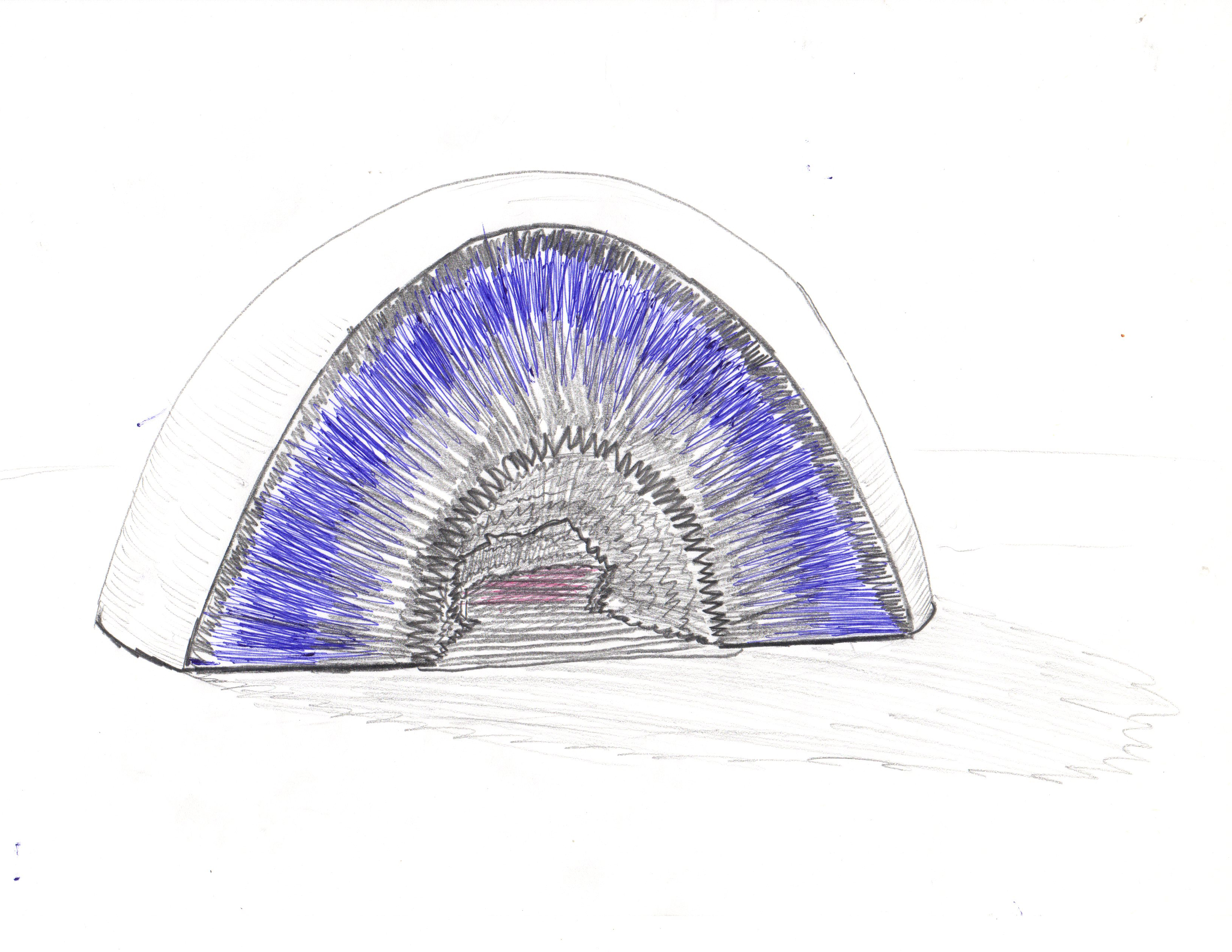
.
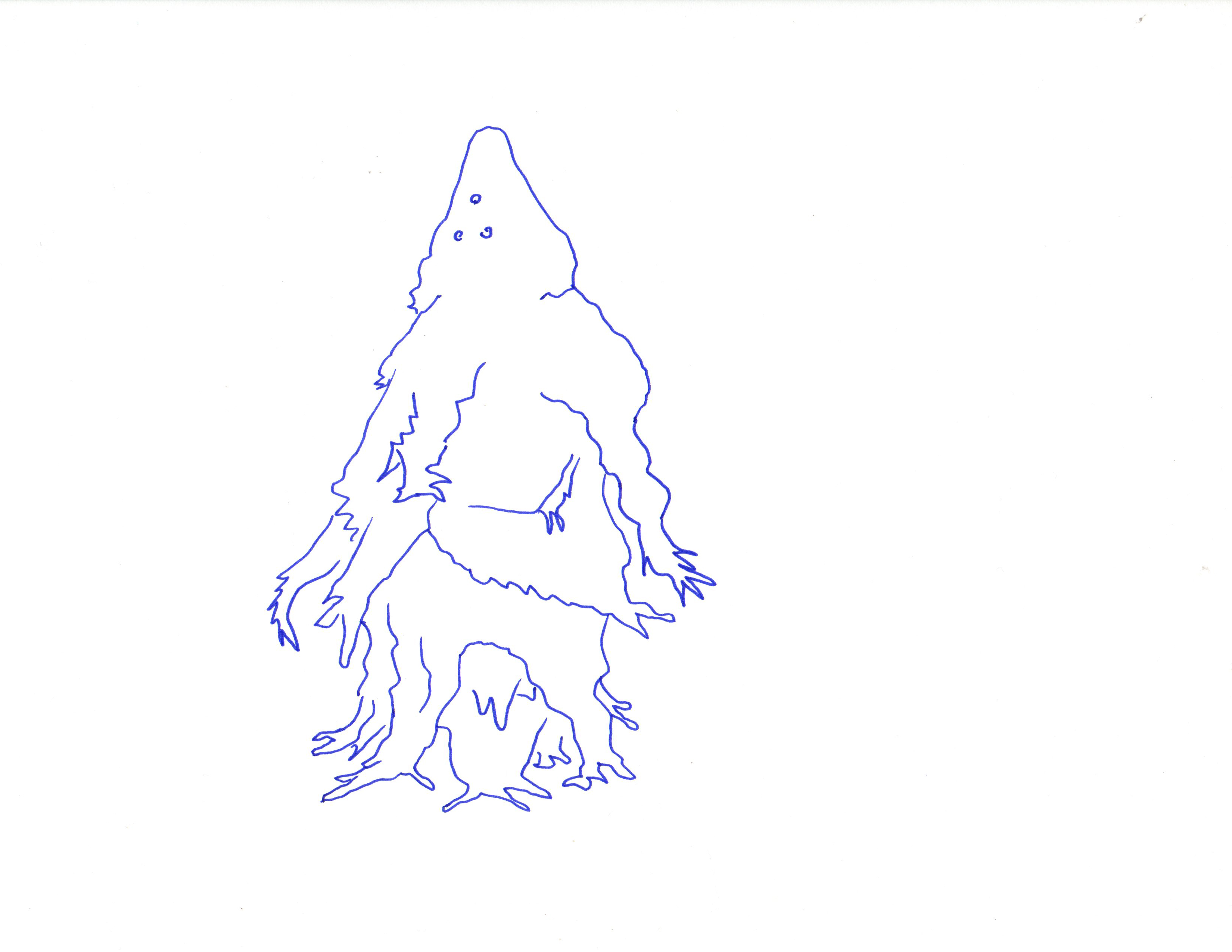
Daniel R. Small, Animus Mneme (Alexey Turchin’s Inside the Stone no.1 and no.2, Wood Spirit), 2015–2018. Three framed drawings, pen and graphite on paper, 12 x 15 inches in artist’s frames. Courtesy of the artist.
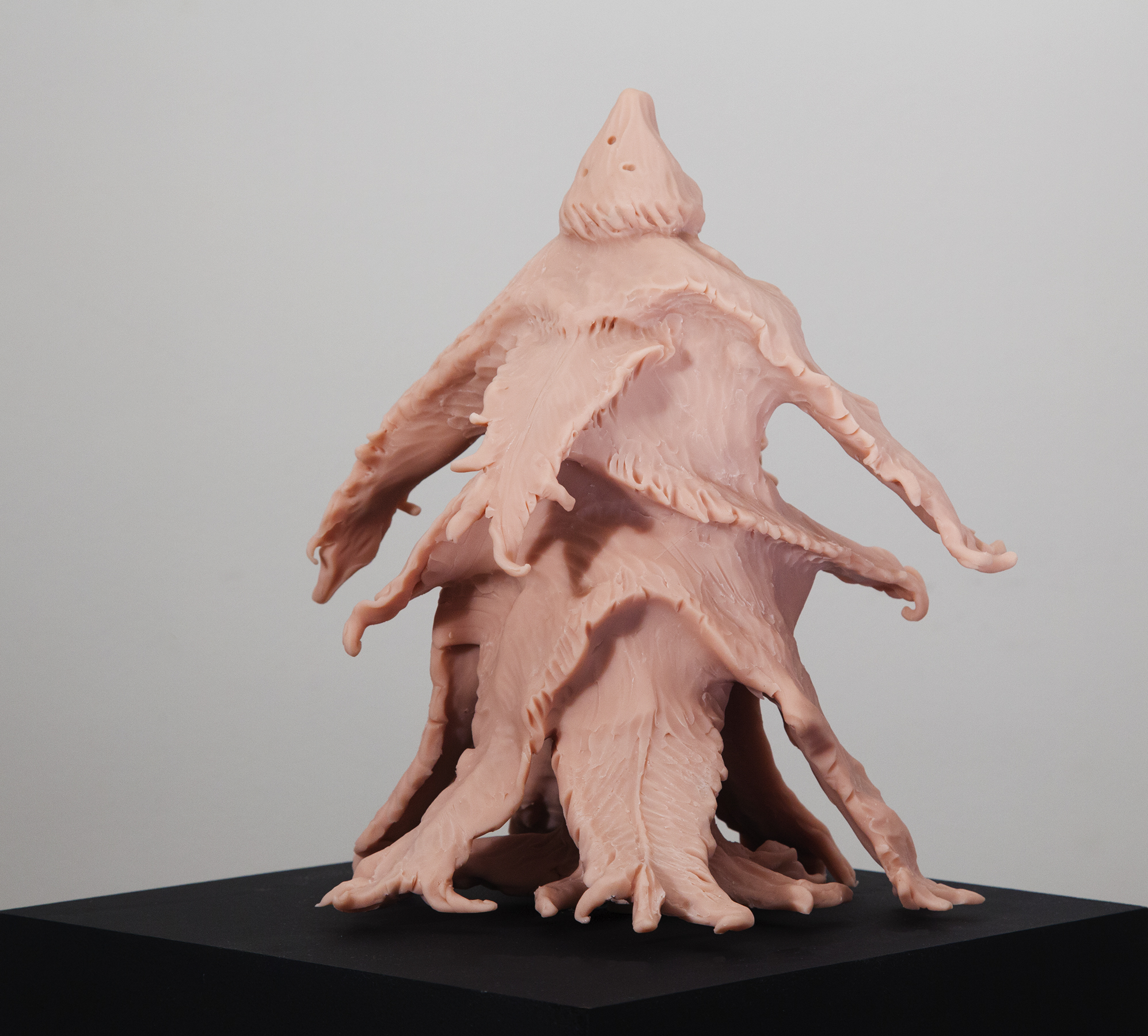
Daniel R. Small, Animus Mneme (Animation model), 2018. Sculpy, 13 x 12 x 13 in.. Courtesy of the artist.
These three drawings were produced by Alexey Turchin, one of the founders of the Longevity Party, and a transhumanist based in Moscow, Russia. The drawings were made during the daily uploading of data he records of almost every aspect of his life. During these uploading sessions, he connects himself to an EEG (electroencephalogram) measuring his brain waves to be deciphered and uploaded to an android that will become the basis for his personality in the afterlife. He refers to these drawings as “automatic,” since he believes he enters a kind of primal state during the sessions. At my request, Turchin sent me a series of these drawings. They will be used as source material to develop concept art for animations, and a Disney animator assisted in the production of the Sculpey model that will be scanned to produce these animations.
Alexey writing on his drawings:
Inside the stone (cave no1 and no2).
When I was a child, I attended a small lecture about stones. An old woman showed me a simple stone, opened it (it was already cut), and there was infinite beauty inside (it was agate). It so impressed me that I searched for the stones on the beach, broke them, but there was no beauty inside. This is one of the obvious inspirations for the drawings, but what is inside the caves I don’t know. It is something connected to the inner secret of simple things.Wood Spirit.
This is probably a forest spirit, the Leshy, a person consisting of wood elements and living in the forest. I also have a long-term interest in triads, that is why he has three eyes, but in this case, it is related to the idea of there being three sexes. I also think that it is some kind of self-portrait. It is an automatic drawing, and I never know what will appear and what it means exactly.
5.
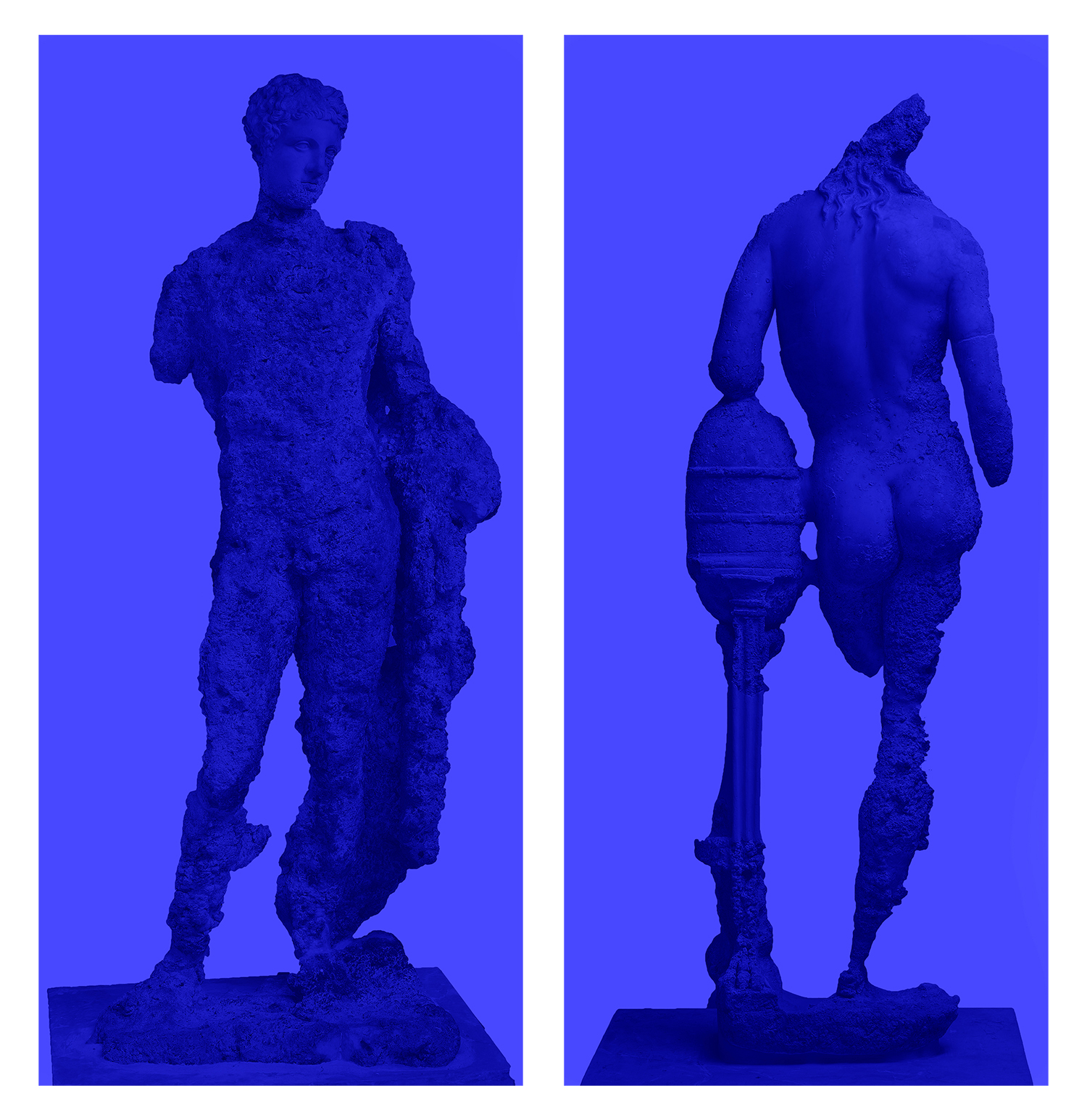
Daniel R. Small, Animus Mneme (Hermes and Apollo), 2018. Digital chromogenic prints, each 22 x 48 in. Courtesy of the artist.
The main cargo on board the Roman ship that carried the Antikythera mechanism consisted of large marble and bronze Hellenistic sculptures, amphora, stone vessels, glass, pottery, and coinage. The wreck was discovered by sponge divers in 1900 off of the island of Antikythera in the Aegean Sea. In one account, the first diver to descend onto the wreck believed that he had been lowered onto a pile of corpses, and vigorously pulled his emergency line to come up. The marble statues that were not buried in sand or silt, were exposed to the water and microorganisms that colonized the sculptures and turned them into coral resembling rotting flesh.
The depiction here of Hermes and Apollo as decrepit decayed corpses, which simultaneously resemble cyborgs in their silhouettes, mirror their mythological resonance and occupy a liminal space between the transformation of Greek Hellenistic sculptures into cyborg amputees. There is a story of Hermes removing the hooves of Apollo’s cattle and putting them on backwards, so it would appear that the cattle were being driven in the opposite direction, creating the perception of making time run in reverse. Perhaps this story is an analog to the discovery of the Antikythera mechanism, and the implausibility of what it articulated when dated to 60 BC.
6.
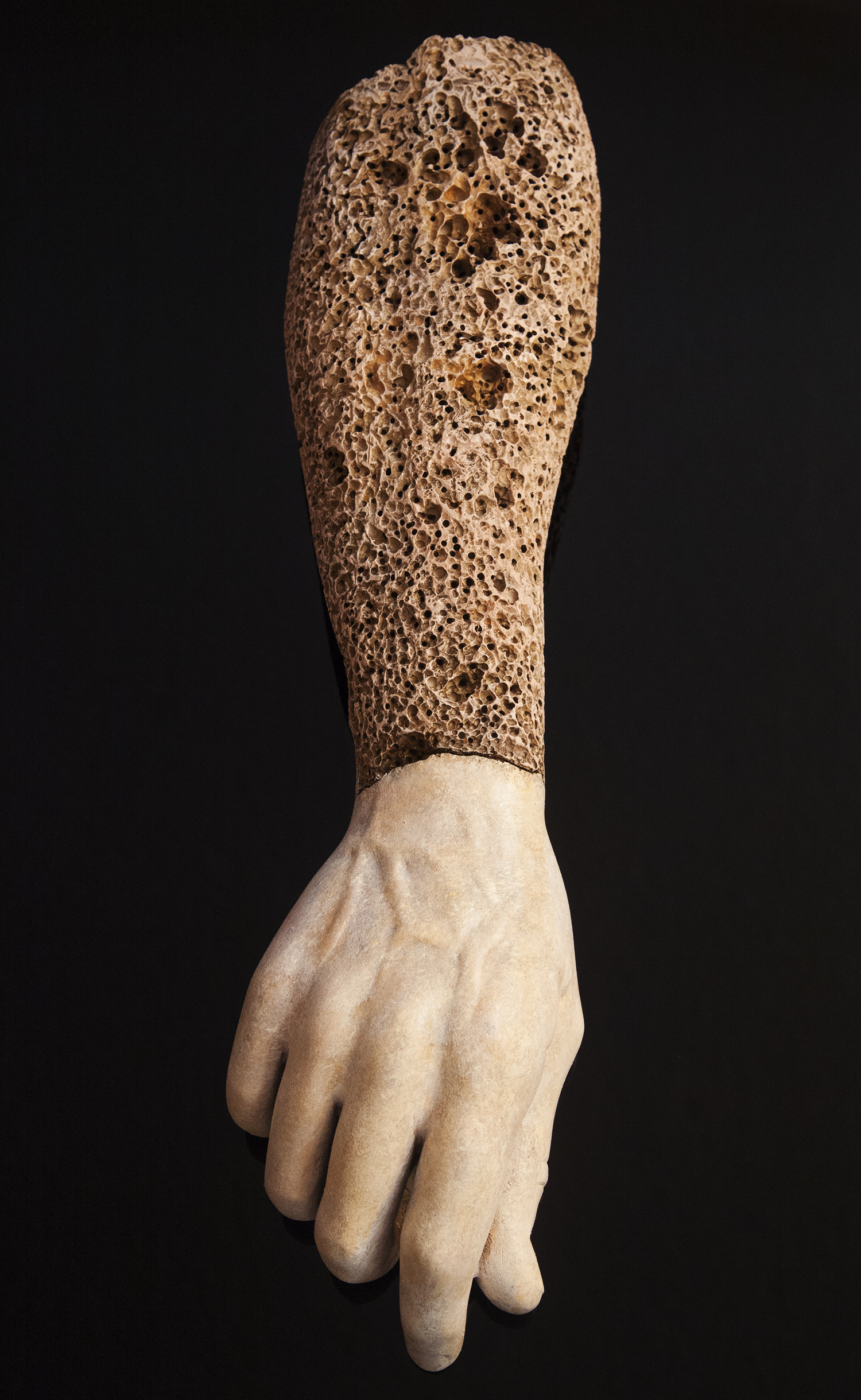
Daniel R. Small, Animus Mneme (Reliquary for an Anonymous Saint), 2018. Carved prototyping foam and acrylic, 4.5 x 24 x 6 in. Courtesy of the artist.
The majority of the pieces of sculptures found on the shipwreck were able to be reconstructed into statues, but one arm was never identified as belonging to any particular sculpture. The hand, buried by sand or other debris, was perfectly preserved, but the forearm and elbow were exposed to the water, coral and other microorganisms that colonized the arm, eating into it, making impossible any future reunion with the rest of the statue. The form of this arm bears an uncanny likeness to medieval reliquaries that hosted the bones or body parts of venerated saints. But in this case, the alchemical transformation results in a relic of nonhuman life. Since severed arms symbolically represent a loss of humanity or agency in able-bodied thinking, it seems paradoxical that this severed marble arm is more animated and autonomous through its separation. It occupies a space between prototype and artifact.
7.
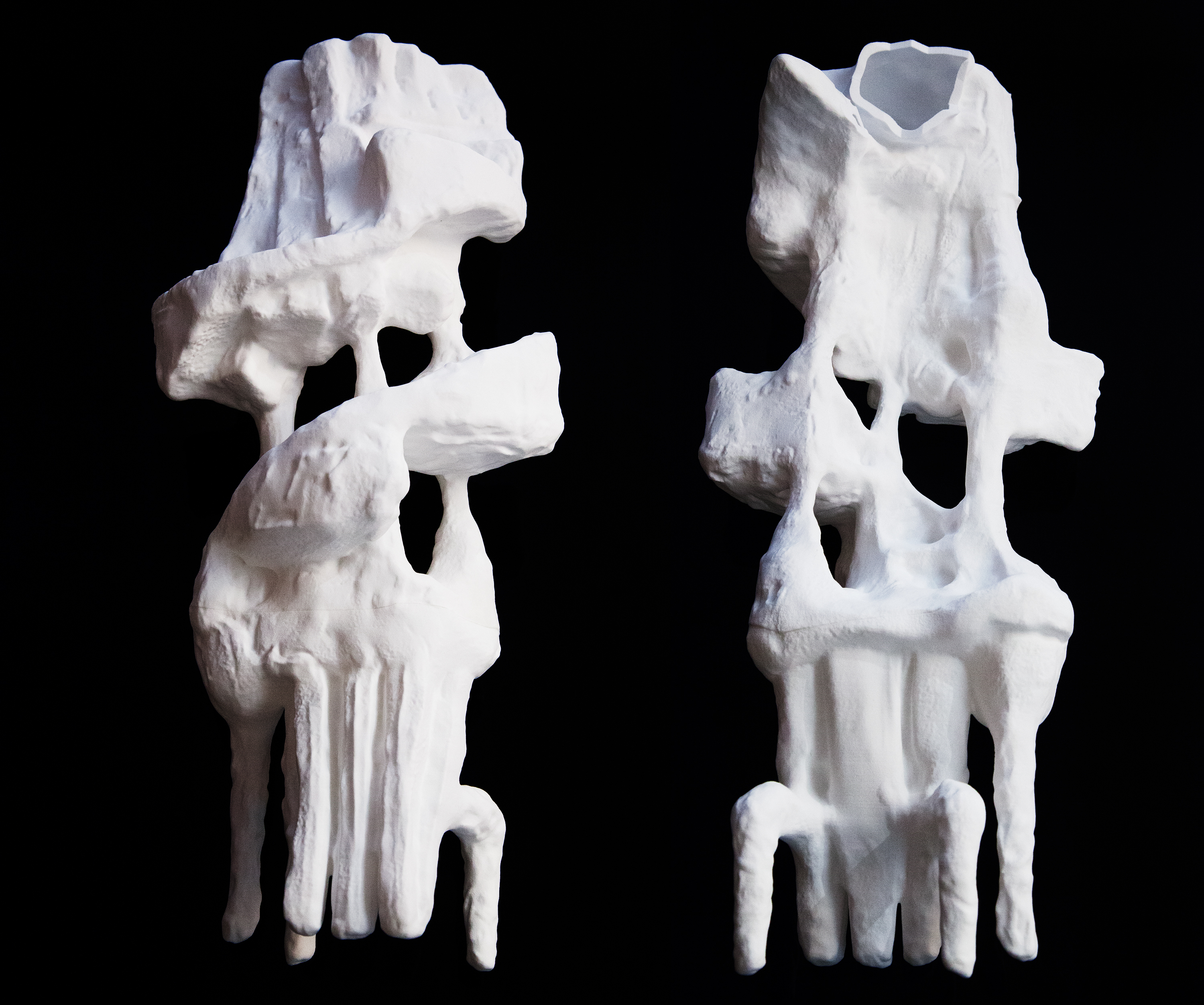
Daniel R. Small, Animus Mneme (Reliquary for an Anonymous Ruin), 2018. 3D prints in white nylon plastic, each 11 x 24 x 6 in. Courtesy of the artist.
The Temple of Lanleff located in Brittany, France is an anonymous ruin with obscure origins. There have been many contradictory theories about it, ranging from a prehistoric structure to a Roman temple from ca. 56 BC under the rule of Julius Caesar to a medieval temple from the 10th century. The artist Henri Etienne-Martin’s series “Demeure,” or dwellings, consists of modernist renderings of sites that were of particular significance at different periods in his life. He spent time at Lanleff, after his time as prisoner of war in World War II. In Lanleff-Demeure no.4 (1961), he worked from his memory of this ruin, and the relationship between the site and the sculpture seems so tenuous that the history of the site is eclipsed by what appears to be clasped mechanized robotic arms.
Pictured above, these altered prototypes, based on Etienne-Martin’s sculpture heighten the double-translated and anthropomorphized form, pointing to the plasticity of the conception and reception of hybrid objects. They lend themselves as transtemporal mnemonic devices—both from the original temple’s producers, and later through Etienne-Martin’s recollection—rather than concretized monuments. x

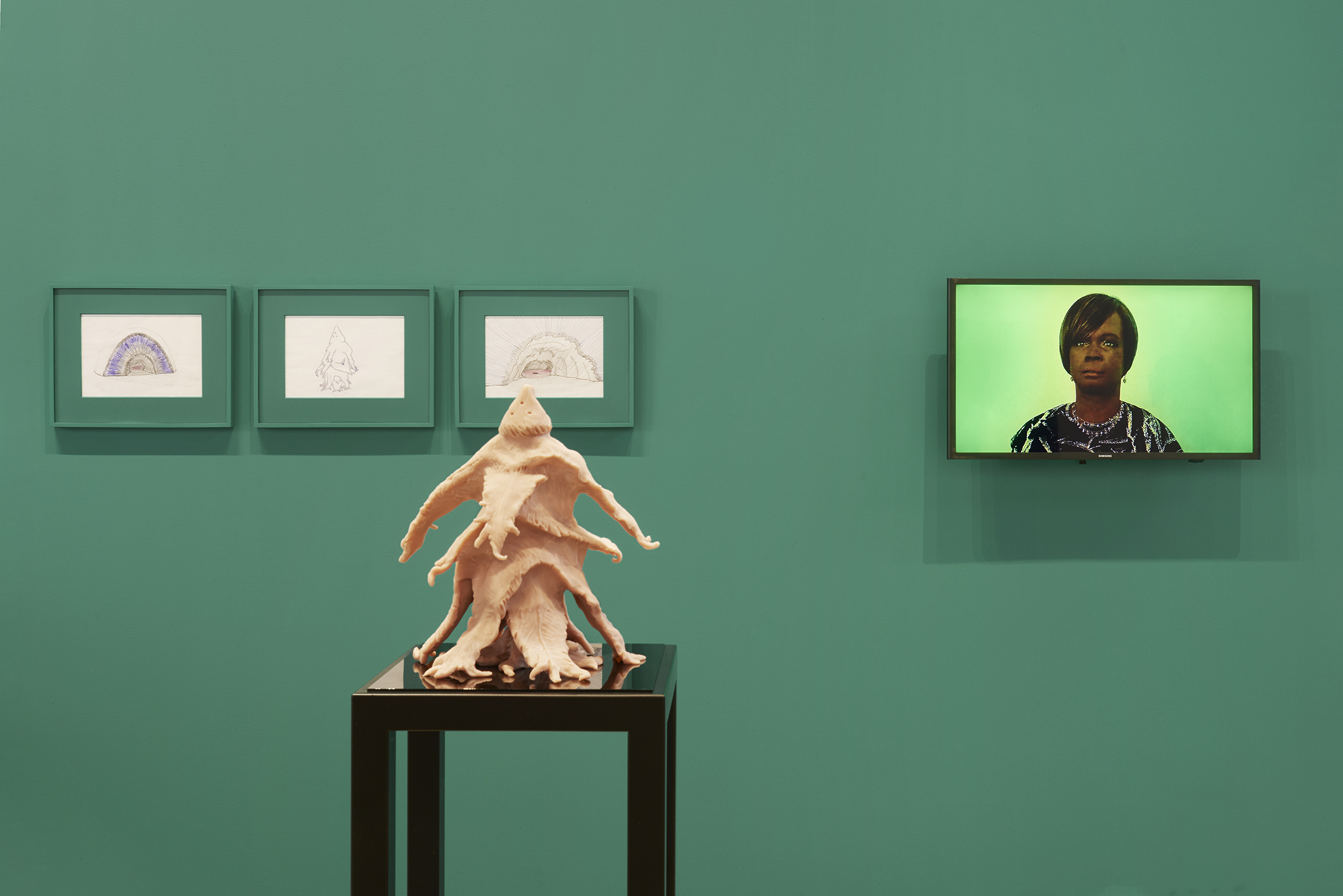
74 million million million tons, installation views, SculptureCenter, Long Island City, April 30–July 30, 2018. Photos: Kyle Knodell.

Daniel R. Small (b.1984) was born in Centralia, Illinois, and currently lives and works in Los Angeles. Small received his BFA from Rhode Island School of Design and Brown University, and received his MFA from San Francisco Art Institute. His work has been featured at Index- The Swedish Contemporary Art Foundation (2017), VENUS LA (2017), Galeria Nicodim (2017), the Hammer Museum’s Made in LA biennial (2016), the 13th Biennale de Lyon, Musee d’Art Contemporain Lyon (2015), and in exhibitions at the Center for Land Use Interpretation, Wendover, UT (2015); PIASA, Paris (2015); Los Angeles Nomadic Division (LAND) (2015); San Francisco Arts Commission (2012); Public Fiction, Los Angeles (2012); and 21st Century Museum of Contemporary Art, Kanazawa, Japan (2011).